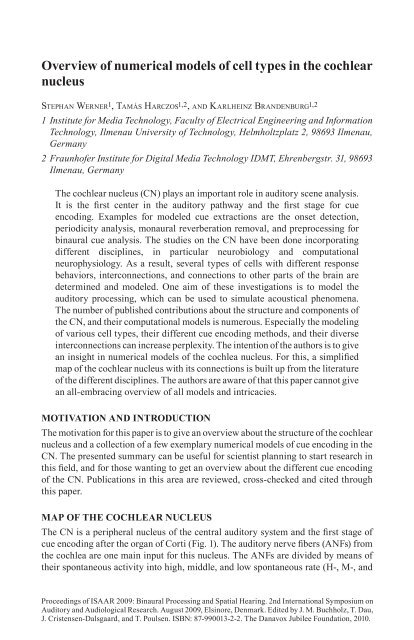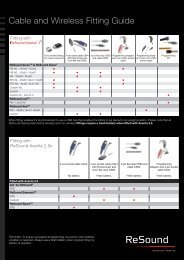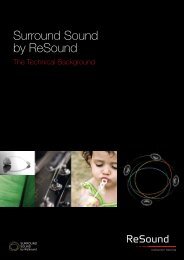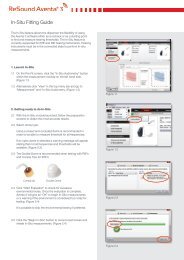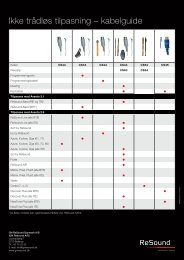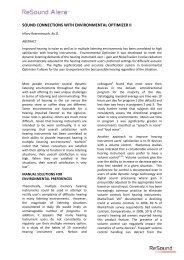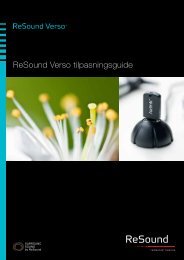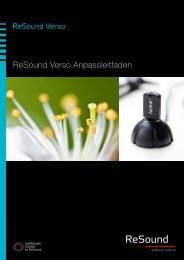Overview of numerical models of cell types in the cochlear nucleus
Overview of numerical models of cell types in the cochlear nucleus
Overview of numerical models of cell types in the cochlear nucleus
Create successful ePaper yourself
Turn your PDF publications into a flip-book with our unique Google optimized e-Paper software.
<strong>Overview</strong> <strong>of</strong> <strong>numerical</strong> <strong>models</strong> <strong>of</strong> <strong>cell</strong> <strong>types</strong> <strong>in</strong> <strong>the</strong> <strong>cochlear</strong><strong>nucleus</strong>St e ph a n We r n e r 1 , Ta m á s Ha r c z o s 1,2 , a n d Ka r l h e i n z Br a n d e n b u r g 1,21 Institute for Media Technology, Faculty <strong>of</strong> Electrical Eng<strong>in</strong>eer<strong>in</strong>g and InformationTechnology, Ilmenau University <strong>of</strong> Technology, Helmholtzplatz 2, 98693 Ilmenau,Germany2 Fraunh<strong>of</strong>er Institute for Digital Media Technology IDMT, Ehrenbergstr. 31, 98693Ilmenau, GermanyThe <strong>cochlear</strong> <strong>nucleus</strong> (CN) plays an important role <strong>in</strong> auditory scene analysis.It is <strong>the</strong> first center <strong>in</strong> <strong>the</strong> auditory pathway and <strong>the</strong> first stage for cueencod<strong>in</strong>g. Examples for modeled cue extractions are <strong>the</strong> onset detection,periodicity analysis, monaural reverberation removal, and preprocess<strong>in</strong>g forb<strong>in</strong>aural cue analysis. The studies on <strong>the</strong> CN have been done <strong>in</strong>corporat<strong>in</strong>gdifferent discipl<strong>in</strong>es, <strong>in</strong> particular neurobiology and computationalneurophysiology. As a result, several <strong>types</strong> <strong>of</strong> <strong>cell</strong>s with different responsebehaviors, <strong>in</strong>terconnections, and connections to o<strong>the</strong>r parts <strong>of</strong> <strong>the</strong> bra<strong>in</strong> aredeterm<strong>in</strong>ed and modeled. One aim <strong>of</strong> <strong>the</strong>se <strong>in</strong>vestigations is to model <strong>the</strong>auditory process<strong>in</strong>g, which can be used to simulate acoustical phenomena.The number <strong>of</strong> published contributions about <strong>the</strong> structure and components <strong>of</strong><strong>the</strong> CN, and <strong>the</strong>ir computational <strong>models</strong> is numerous. Especially <strong>the</strong> model<strong>in</strong>g<strong>of</strong> various <strong>cell</strong> <strong>types</strong>, <strong>the</strong>ir different cue encod<strong>in</strong>g methods, and <strong>the</strong>ir diverse<strong>in</strong>terconnections can <strong>in</strong>crease perplexity. The <strong>in</strong>tention <strong>of</strong> <strong>the</strong> authors is to givean <strong>in</strong>sight <strong>in</strong> <strong>numerical</strong> <strong>models</strong> <strong>of</strong> <strong>the</strong> cochlea <strong>nucleus</strong>. For this, a simplifiedmap <strong>of</strong> <strong>the</strong> <strong>cochlear</strong> <strong>nucleus</strong> with its connections is built up from <strong>the</strong> literature<strong>of</strong> <strong>the</strong> different discipl<strong>in</strong>es. The authors are aware <strong>of</strong> that this paper cannot givean all-embrac<strong>in</strong>g overview <strong>of</strong> all <strong>models</strong> and <strong>in</strong>tricacies.MOTIVATION AND INTRODUCTIONThe motivation for this paper is to give an overview about <strong>the</strong> structure <strong>of</strong> <strong>the</strong> <strong>cochlear</strong><strong>nucleus</strong> and a collection <strong>of</strong> a few exemplary <strong>numerical</strong> <strong>models</strong> <strong>of</strong> cue encod<strong>in</strong>g <strong>in</strong> <strong>the</strong>CN. The presented summary can be useful for scientist plann<strong>in</strong>g to start research <strong>in</strong>this field, and for those want<strong>in</strong>g to get an overview about <strong>the</strong> different cue encod<strong>in</strong>g<strong>of</strong> <strong>the</strong> CN. Publications <strong>in</strong> this area are reviewed, cross-checked and cited throughthis paper.MAP OF THE COCHLEAR NUCLEUSThe CN is a peripheral <strong>nucleus</strong> <strong>of</strong> <strong>the</strong> central auditory system and <strong>the</strong> first stage <strong>of</strong>cue encod<strong>in</strong>g after <strong>the</strong> organ <strong>of</strong> Corti (Fig. 1). The auditory nerve fibers (ANFs) from<strong>the</strong> cochlea are one ma<strong>in</strong> <strong>in</strong>put for this <strong>nucleus</strong>. The ANFs are divided by means <strong>of</strong><strong>the</strong>ir spontaneous activity <strong>in</strong>to high, middle, and low spontaneous rate (H-, M-, andProceed<strong>in</strong>gs <strong>of</strong> ISAAR 2009: B<strong>in</strong>aural Process<strong>in</strong>g and Spatial Hear<strong>in</strong>g. 2nd International Symposium onAuditory and Audiological Research. August 2009, Els<strong>in</strong>ore, Denmark. Edited by J. M. Buchholz, T. Dau,J. Cristensen-Dalsgaard, and T. Poulsen. ISBN: 87-990013-2-2. The Danavox Jubilee Foundation, 2010.
Stephan Werner et al.LSR, respectively). The several regions <strong>of</strong> <strong>the</strong> CN are excited by different <strong>types</strong> <strong>of</strong><strong>the</strong>se ANFs <strong>in</strong> dependence <strong>of</strong> <strong>the</strong> <strong>in</strong>tensity <strong>of</strong> <strong>the</strong> sound signal. Non-ANF term<strong>in</strong>alsare from higher regions <strong>of</strong> <strong>the</strong> auditory pathway and from outside <strong>the</strong> auditory system(Ehret and Romand, 1997). Figure 1 shows <strong>the</strong> ascend<strong>in</strong>g auditory pathway for <strong>the</strong>left side start<strong>in</strong>g with <strong>the</strong> auditory nerve fibers.A simplified map <strong>of</strong> <strong>the</strong> CN with its divisions, signal flow, and <strong>in</strong>terconnections isshown <strong>in</strong> Fig. 2 at <strong>the</strong> end <strong>of</strong> this chapter. This map was built up from literature,ma<strong>in</strong>ly from Ehret and Romand (1997), Oertel and Gold<strong>in</strong>g (1997), Oertel and Young(2004), Tzounopoulos et al. (2004), and was cross-checked with o<strong>the</strong>r literaturefrom computational neurophysiology. Only <strong>the</strong> distribution <strong>of</strong> ma<strong>in</strong> <strong>cell</strong> <strong>types</strong>, <strong>the</strong>ascend<strong>in</strong>g pathway, and no feedback control with<strong>in</strong> <strong>the</strong> CN are shown <strong>in</strong> Fig. 2. Theconvergent <strong>in</strong>puts from several auditory nerve fibers to <strong>the</strong> neurons <strong>in</strong> <strong>the</strong> AVCN arenot presented <strong>in</strong> Fig. 2 to keep perspicuity <strong>of</strong> <strong>the</strong> figure. Only <strong>the</strong> characteristic <strong>in</strong>putis shown.Fig. 1: Ascend<strong>in</strong>g auditory pathway (left pathway). From Ehret and Romand (1997).DivisionsThe CN is divided <strong>in</strong>to three ma<strong>in</strong> regions with a tonotopic like structure. Theseregions are <strong>the</strong> rostral and caudal anteroventral part (AVCN), <strong>the</strong> posteroventral part(PVCN), and <strong>the</strong> dorsal part <strong>of</strong> <strong>the</strong> CN (DCN). The caudal AVCN and <strong>the</strong> PVCNreceive <strong>the</strong>ir ma<strong>in</strong> <strong>in</strong>puts from auditory nerve fibers (Ehret and Romand, 1997).The DCN receive <strong>in</strong>puts from <strong>the</strong> ANFs and from <strong>the</strong> so called mossy fibers fromo<strong>the</strong>r regions <strong>of</strong> <strong>the</strong> bra<strong>in</strong>. These <strong>in</strong>puts convey signals for <strong>the</strong> head and ear position62
<strong>Overview</strong> <strong>of</strong> <strong>numerical</strong> <strong>models</strong> <strong>of</strong> <strong>cell</strong> <strong>types</strong> <strong>in</strong> <strong>the</strong> <strong>cochlear</strong> <strong>nucleus</strong>(Tzounopoulos et al., 2004), signals from higher stages <strong>of</strong> <strong>the</strong> auditory pathway,and from o<strong>the</strong>r regions <strong>of</strong> <strong>the</strong> bra<strong>in</strong> (Oertel and Young, 2004). The rostral AVCN isfur<strong>the</strong>r divisible <strong>in</strong>to an anterior and posterior area <strong>of</strong> <strong>the</strong> anterior part. The caudalAVCN is divisible <strong>in</strong>to a ventral and dorsal area <strong>of</strong> <strong>the</strong> posterior part. The DCN canbe anatomically divided <strong>in</strong>to <strong>the</strong> molecular, pyramidal, and polymorphic <strong>cell</strong> layerwith its dedicated <strong>cell</strong>s (Ehret and Romand, 1997; Oertel and Gold<strong>in</strong>g, 1997; Oerteland Young, 2004; Tzounopoulos et al., 2004).Cell <strong>types</strong>The neurons with<strong>in</strong> <strong>the</strong> CN can be classified by <strong>the</strong>ir response patterns to tone-burstsand by <strong>the</strong>ir morphology. Investigations <strong>of</strong> e.g. cat bra<strong>in</strong> show that generally <strong>the</strong>re aredifferent <strong>cell</strong> <strong>types</strong> <strong>in</strong> different regions <strong>of</strong> <strong>the</strong> CN (see Fig. 2).Spherical bushy <strong>cell</strong>s can be found <strong>in</strong> <strong>the</strong> rostral part <strong>of</strong> <strong>the</strong> AVCN. They show aresponse pattern which is very similar to that <strong>of</strong> auditory nerve fibers. Those neuronsare called “primary-like”. They are excited by tonotopic structured ANFs. Theiroutputs go through <strong>the</strong> trapezoid body to <strong>the</strong> <strong>nucleus</strong> <strong>of</strong> <strong>the</strong> lateral lem<strong>in</strong>iscus and to<strong>the</strong> superior olive complex.Globular bushy <strong>cell</strong>s and stellate <strong>cell</strong>s can be found <strong>in</strong> <strong>the</strong> caudal part <strong>of</strong> <strong>the</strong> AVCN.Globular bushy <strong>cell</strong>s show primary-like with notch behavior, which means that <strong>the</strong>reis a short decrease <strong>of</strong> activity after <strong>the</strong> sharp onset peak <strong>of</strong> activity. The onset peakis time-locked to <strong>the</strong> stimulus onset. They show a high precision on phase lock<strong>in</strong>g<strong>of</strong> <strong>the</strong> sound signal (Wittig jr., 2004). They achieve excitatory <strong>in</strong>puts from <strong>the</strong>tonotopic structured ANFs and <strong>in</strong>hibitory <strong>in</strong>put from tuberculoventral <strong>cell</strong>s <strong>in</strong> <strong>the</strong>DCN. The outputs <strong>of</strong> <strong>the</strong>se <strong>cell</strong>s are <strong>the</strong> trapezoid body and periolivary <strong>nucleus</strong>. Thestellate <strong>cell</strong>s <strong>in</strong> <strong>the</strong> AVCN show an onset response with weak discharge after <strong>the</strong>onset <strong>of</strong> <strong>the</strong> tone-burst. They are called onset-type 1 (on-1). They are excited by <strong>the</strong>tonotopic structured ANFs and have <strong>in</strong>hibitory <strong>in</strong>puts from tuberculoventral <strong>cell</strong>s<strong>in</strong> <strong>the</strong> DCN. The term<strong>in</strong>als <strong>of</strong> <strong>the</strong>se <strong>cell</strong>s are located <strong>in</strong> <strong>the</strong> lateral lem<strong>in</strong>iscus and<strong>in</strong>ferior colliculus.The PVCN conta<strong>in</strong>s two fur<strong>the</strong>r <strong>cell</strong> <strong>types</strong>. One type is <strong>the</strong> d-stellate <strong>cell</strong>, whichshows chopper behavior. The envelope <strong>of</strong> <strong>the</strong> response pattern is similar to primarylikeresponse, but with multiple peaks separated by periodic time <strong>in</strong>tervals. Oerteland Young (2004) describe that <strong>the</strong> <strong>in</strong>hibitory outputs proceed to tuberculoventral<strong>cell</strong>s, pyramidal and giant <strong>cell</strong>s <strong>in</strong> <strong>the</strong> DCN and next to this to <strong>the</strong> periolivary <strong>nucleus</strong>.The second <strong>cell</strong> type <strong>in</strong> <strong>the</strong> PVCN is <strong>the</strong> octopus <strong>cell</strong>, which shows ideal onset (on-i)behavior to stimulus onset. Their axons go to <strong>the</strong> <strong>in</strong>ferior colliculus and periolivary<strong>nucleus</strong>.The tuberculoventral <strong>cell</strong>s <strong>in</strong> <strong>the</strong> DCN show chopper and onset-chopper behavior. The<strong>in</strong>puts are <strong>the</strong> tonotopic structured ANFs and <strong>in</strong>hibitory <strong>in</strong>put from d-stellate <strong>cell</strong>s.Their <strong>in</strong>hibitory outputs go to <strong>the</strong> caudal part <strong>of</strong> <strong>the</strong> AVCN (Ehret and Romand, 1997),and to <strong>the</strong> pyramidal <strong>cell</strong>s <strong>in</strong> <strong>the</strong> second <strong>cell</strong> layer <strong>of</strong> <strong>the</strong> DCN (Oertel and Young,2004; Oertel and Gold<strong>in</strong>g, 1997).63
Stephan Werner et al.Giant <strong>cell</strong>s <strong>in</strong> <strong>the</strong> DCN receive several <strong>in</strong>hibitory <strong>in</strong>puts from parts <strong>of</strong> <strong>the</strong> DCN andPVCN. They show build-up behavior which means that onset <strong>of</strong> <strong>the</strong> tone-burst issuppressed followed by an <strong>in</strong>crease <strong>in</strong> excitation. The pyramidal <strong>cell</strong>s <strong>in</strong> <strong>the</strong> DCNshow a very similar response pattern (pauser). The difference is that <strong>the</strong> suppressionstarts after <strong>the</strong> first <strong>in</strong>itial peak. The onset <strong>of</strong> <strong>the</strong> stimulus is encoded. Giant andpyramidal <strong>cell</strong>s encode sharp spectral features like notches, which are coursed e.g.by <strong>the</strong> head related transfer function (Oertel and Young, 2004; Wittig jr., 2004). These<strong>cell</strong>s are excited by ANFs and parallel fibers. Several <strong>in</strong>hibitory <strong>in</strong>puts are from parts<strong>of</strong> <strong>the</strong> PVCN and <strong>the</strong> non-tonotopic structured circuits <strong>of</strong> cartwheel and superficialstellate <strong>cell</strong>s <strong>in</strong> <strong>the</strong> first <strong>cell</strong> layer <strong>of</strong> <strong>the</strong> DCN (Oertel and Young, 2004; Oertel andGold<strong>in</strong>g, 1997). The output <strong>of</strong> <strong>the</strong> pyramidal <strong>cell</strong>s goes to <strong>the</strong> <strong>in</strong>ferior colliculus andlateral lem<strong>in</strong>iscus (ventral and <strong>in</strong> m<strong>in</strong>or dorsal).MODELING THE COCHLEA NUCLEUSIn this chapter a few selected computational <strong>models</strong> <strong>of</strong> <strong>the</strong> CN are presented. These<strong>models</strong> or parts <strong>of</strong> <strong>the</strong>m are assigned to <strong>the</strong> assumed cue encod<strong>in</strong>g, divisions and <strong>cell</strong><strong>types</strong> <strong>of</strong> <strong>the</strong> CN. Please note that this is not a complete l<strong>in</strong>e-up.Cue encod<strong>in</strong>g <strong>in</strong> <strong>the</strong> Cochlea NucleusMa<strong>in</strong> acoustical cues which are encoded by <strong>the</strong> auditory system are <strong>the</strong> amplitudemodulation (AM) and periodicity <strong>of</strong> a sound signal. Fris<strong>in</strong>a et al. (1990) found thatneurons <strong>in</strong> <strong>the</strong> VCN encode AM. He and his colleagues identified on-1 and chopperunits <strong>in</strong> <strong>the</strong> AVCN and on-i units <strong>in</strong> <strong>the</strong> PVCN to be specialized for encod<strong>in</strong>g <strong>of</strong> AM.These <strong>cell</strong>s are tuned to preferred AM frequencies to which <strong>the</strong>y are maximallyresponsive. Gai and Carney (2008) are compliant with o<strong>the</strong>r studies that <strong>in</strong>hibitory<strong>in</strong>puts are generally enhanc<strong>in</strong>g <strong>the</strong> synchronization to AM. They assume that most<strong>in</strong>hibitory <strong>in</strong>terneurons <strong>in</strong> <strong>the</strong> CN are synchronized to AM. It seemed that especially<strong>the</strong> PVCN is a key area for encod<strong>in</strong>g AM (e.g. Gai and Carney, 2008). The d-stellateunits seemed to be encod<strong>in</strong>g <strong>the</strong> mean discharge rates <strong>of</strong> ANFs and hence <strong>the</strong> periods<strong>of</strong> arriv<strong>in</strong>g signals, and give a k<strong>in</strong>d <strong>of</strong> trigger signal to some CN units at higher stages<strong>of</strong> <strong>the</strong> auditory pathway. The octopus units <strong>in</strong> <strong>the</strong> PVCN are assumed to encode <strong>the</strong>onsets <strong>of</strong> a signal and may play an essential role <strong>in</strong> periodicity encod<strong>in</strong>g (Ehret andRomand, 1997). Next to this, neurons are identified <strong>in</strong> <strong>the</strong> AVCN, which receiveconvergent <strong>in</strong>puts from auditory nerve fibers with different characteristic frequency(Carney, 1990). These neurons appear to behave like cross-correlators to detectsimilar patterns <strong>of</strong> periodicities <strong>in</strong> frequency channels (Wang and Brown, 1999).Tuberculoventral <strong>cell</strong>s <strong>in</strong> <strong>the</strong> DCN have <strong>in</strong>hibitory projections to AVCN units. Theconnected neurons <strong>in</strong> <strong>the</strong> DCN and AVCN are excited by auditory nerve fibers with<strong>the</strong> same characteristic frequency. Experiments show that <strong>the</strong> <strong>in</strong>hibitory potentials <strong>of</strong>DCN <strong>cell</strong>s reach <strong>the</strong> AVCN 2 ms after stimulat<strong>in</strong>g <strong>the</strong> ANF. Bürck and van Hemmen(2007) conclude that <strong>the</strong>re is a very important function <strong>of</strong> <strong>the</strong> CN that appears to bemonaural echo suppression.64
<strong>Overview</strong> <strong>of</strong> <strong>numerical</strong> <strong>models</strong> <strong>of</strong> <strong>cell</strong> <strong>types</strong> <strong>in</strong> <strong>the</strong> <strong>cochlear</strong> <strong>nucleus</strong>Fig. 2: Map <strong>of</strong> <strong>the</strong> cochlea <strong>nucleus</strong>; signal flow is shown for three auditory nerve fibersas <strong>in</strong>put.65
Stephan Werner et al.The outputs <strong>of</strong> <strong>the</strong> CN are <strong>in</strong>nervat<strong>in</strong>g <strong>the</strong> superior olivary complex (SOC) and <strong>the</strong><strong>in</strong>ferior colliculus (IC) <strong>of</strong> <strong>the</strong> ipsi and contra lateral side. These regions are key areasfor encod<strong>in</strong>g b<strong>in</strong>aural cues like <strong>in</strong>teraural time (ITD) and level differences (ILD).The globular and spherical bushy <strong>cell</strong>s <strong>in</strong> <strong>the</strong> AVCN have a more precise encod<strong>in</strong>g<strong>of</strong> <strong>the</strong> acoustic waveform phase than <strong>the</strong> ANFs, which is helpful for sound sourcelocalization (Wittig jr., 2004; Louage et al., 2005). The two CNs seemed to bepreprocess<strong>in</strong>g stages for b<strong>in</strong>aural cue extraction (Ehret and Romand, 1997; Voutsasand Adamy, 2007). Oertel and Young (2004) describe that <strong>the</strong> <strong>in</strong>hibitory circuitsbetween <strong>the</strong> giant and pyramidal <strong>cell</strong>s <strong>in</strong> <strong>the</strong> DCN allows encod<strong>in</strong>g peaks and notches<strong>in</strong> <strong>the</strong> spectra <strong>of</strong> sounds. Spectral notches can be caused by <strong>the</strong> head related transferfunction and superimposed sound fields. They may be important for spatial encod<strong>in</strong>g<strong>in</strong> <strong>the</strong> IC. Next to this, <strong>the</strong> DCN is also excited by multimodal <strong>in</strong>puts from higherregions <strong>of</strong> <strong>the</strong> bra<strong>in</strong>. It can be supposed that <strong>the</strong>se <strong>in</strong>puts are provid<strong>in</strong>g a k<strong>in</strong>d <strong>of</strong> topdown<strong>in</strong>formation and may play a role <strong>in</strong> a schema-driven process.Periodicity detectionWang and Brown (1999) built a computational neural model for segregat<strong>in</strong>g speechfrom <strong>in</strong>terfer<strong>in</strong>g sound sources by an oscillatory correlation. One stage <strong>of</strong> <strong>the</strong>ir modelis <strong>the</strong> estimation <strong>of</strong> <strong>the</strong> fundamental frequency by auto-correlation. Ano<strong>the</strong>r featureis <strong>the</strong> periodicity and amplitude modulation <strong>of</strong> a sound signal, which is supportedby Fris<strong>in</strong>a et al. (1990). They do this by cross-correlation between adjacent autocorrelogramchannels. Borst et al. (2004) and Voutsas et al. (2005) developed abiologically <strong>in</strong>spired model to extract <strong>the</strong> periodicity <strong>of</strong> complex sounds. Theyconnect <strong>the</strong> signal process<strong>in</strong>g <strong>of</strong> various neurons <strong>in</strong> <strong>the</strong> CN with neurons <strong>of</strong> <strong>the</strong> IC(Fig. 3).One modeled neuron is a trigger neuron, which conforms to onset behavior. In Fig. 2it can be allocated with <strong>the</strong> d-stellate units <strong>in</strong> <strong>the</strong> PVCN, which show onset-chopperbehavior. They forward <strong>the</strong>ir signal to several <strong>cell</strong>s <strong>in</strong> <strong>the</strong> DCN. O<strong>the</strong>r neurons are <strong>the</strong>oscillator neurons, which are triggered by d-stellate units. Borst et al. (2004) locate<strong>the</strong>se neurons <strong>in</strong> <strong>the</strong> VCN as chopper neurons. But <strong>the</strong>re is some evidence that, <strong>in</strong>this case, <strong>the</strong> mentioned units may be tuberculoventral <strong>cell</strong>s <strong>in</strong> <strong>the</strong> DCN (Ehret andRomand, 1997). They are triggered by d-stellate units and show a chopper behavior.Fur<strong>the</strong>r <strong>numerical</strong> <strong>models</strong> for represent<strong>in</strong>g periodic sounds are e.g. <strong>the</strong> simulation <strong>of</strong>chopper units <strong>in</strong> <strong>the</strong> VCN by Wiegrebe and Meddis (2004) and a model <strong>in</strong>troduced byFriedel et al. (2007), which is based on <strong>the</strong> idea <strong>of</strong> delay l<strong>in</strong>es to detect periodicities.Next to this, Kalluri and Delgutte (2003) modeled onset neurons <strong>in</strong> <strong>the</strong> PVCN andAVCN to understand <strong>the</strong>ir behavior as co<strong>in</strong>cidence-detector. Onset behavior is veryimportant to detect periodicities <strong>in</strong> a sound signal (Hemmert et al., 2005), and toimplement monaural auditory segmentation (e.g. Hu and Wang, 2004, 2007).66
<strong>Overview</strong> <strong>of</strong> <strong>numerical</strong> <strong>models</strong> <strong>of</strong> <strong>cell</strong> <strong>types</strong> <strong>in</strong> <strong>the</strong> <strong>cochlear</strong> <strong>nucleus</strong>Fig. 3: Model from Borst et al. (2004).Monaural echo suppressionBürck and van Hemmen (2007) developed a ma<strong>the</strong>matical model <strong>of</strong> <strong>the</strong> CN, whichdeals with <strong>in</strong>hibitory <strong>in</strong>terconnections between DCN and AVCN (Fig. 4). This modelgives <strong>the</strong> possibilities to implement a k<strong>in</strong>d <strong>of</strong> ga<strong>in</strong> control, contrast enhancement, andmonaural echo suppression. In <strong>the</strong> map <strong>of</strong> <strong>the</strong> CN (Fig. 2) one can f<strong>in</strong>d <strong>the</strong> modeledneurons as tuberculoventral <strong>cell</strong>s <strong>in</strong> <strong>the</strong> DCN and as globular bushy <strong>cell</strong>s <strong>in</strong> <strong>the</strong> caudalpart <strong>of</strong> <strong>the</strong> AVCN.Fig. 4: Model from Bürck and van Hemmen (2007). Black circles are <strong>in</strong>hibitorysynapses, white circles are excitatory synapses, dashed l<strong>in</strong>es represent spread<strong>in</strong>g <strong>of</strong><strong>in</strong>hibition.O<strong>the</strong>r sources mention that <strong>the</strong> tuberculoventral units achieve additional <strong>in</strong>hibitory<strong>in</strong>put from <strong>the</strong> d-stellate units <strong>in</strong> <strong>the</strong> PVCN (e.g. Oertel and Young, 2004). These unitsare assigned as trigger neurons, which are phase-coupled to <strong>the</strong> period <strong>of</strong> <strong>the</strong> envelope<strong>of</strong> <strong>the</strong> <strong>in</strong>put signal (Borst et al., 2004).67
Stephan Werner et al.Preprocess<strong>in</strong>g for b<strong>in</strong>aural cue extractionVoutsas and Adamy (2007) developed a biologically <strong>in</strong>spired neural model for soundsource localization based on delay l<strong>in</strong>es <strong>in</strong> <strong>the</strong> sense <strong>of</strong> <strong>the</strong> Jeffress model. Theestimation <strong>of</strong> <strong>the</strong> direction <strong>of</strong> arrival is done for <strong>in</strong>teraural time and level differences.In <strong>the</strong>ir paper <strong>the</strong>y describe <strong>the</strong> signal flow through <strong>the</strong> AVCN for ITD and ILD.The signals for ITD analysis go through <strong>the</strong> spherical bushy <strong>cell</strong>s <strong>in</strong> AVCN to <strong>the</strong>medial superior olive (MSO). The globular bushy <strong>cell</strong>s <strong>in</strong> <strong>the</strong> AVCN are <strong>in</strong>volved <strong>in</strong>ILD analysis. The next signal process<strong>in</strong>g step for ILDs is <strong>in</strong> <strong>the</strong> lateral superior olive(LSO). It has to be noted that <strong>the</strong> globular bushy units are also <strong>in</strong>volved <strong>in</strong> <strong>the</strong> assumedmonaural echo suppression described by Bürck and van Hemmen (2007), and <strong>in</strong> <strong>the</strong>periodicity detection described by Wang and Brown (1999).Schauer et al. (2007) and Pecka et al. (2007) describe an approach for sound sourcelocalization which deals with signal process<strong>in</strong>g <strong>in</strong> <strong>the</strong> IC. Schauer et al. (2007)assume that a sharpen<strong>in</strong>g <strong>of</strong> <strong>the</strong> tonotopic b<strong>in</strong>aural feature representation is doneby lateral <strong>in</strong>terconnections, and a summation <strong>of</strong> <strong>the</strong> tonotopic representation isdone <strong>in</strong> <strong>the</strong> IC. Pecka et al. (2007) expect that DNLL (dorsal <strong>nucleus</strong> <strong>of</strong> <strong>the</strong> laterallem<strong>in</strong>iscus) neurons generate a context-dependent suppression (persistent <strong>in</strong>hibition)<strong>of</strong> directional <strong>in</strong>formation. This is may be <strong>in</strong> l<strong>in</strong>e with <strong>the</strong> encod<strong>in</strong>g <strong>of</strong> spectralnotches by DCN neurons.CONCLUSIONA map <strong>of</strong> <strong>the</strong> <strong>cochlear</strong> <strong>nucleus</strong> (CN) is build up from <strong>the</strong> literature <strong>of</strong> physiologicaland computational neurosciences. This map shows <strong>the</strong> pr<strong>in</strong>cipal structure, <strong>cell</strong> <strong>types</strong>,<strong>in</strong>terconnections and output term<strong>in</strong>als from an eng<strong>in</strong>eer<strong>in</strong>g po<strong>in</strong>t <strong>of</strong> view. Some<strong>numerical</strong> <strong>models</strong> <strong>of</strong> auditory cue encod<strong>in</strong>g are assigned to <strong>the</strong> different <strong>cell</strong> <strong>types</strong> <strong>of</strong><strong>the</strong> CN. Some cue encod<strong>in</strong>g <strong>models</strong> are described briefly which can be a start<strong>in</strong>g po<strong>in</strong>tfor fur<strong>the</strong>r read<strong>in</strong>g. An <strong>in</strong>terest<strong>in</strong>g field <strong>of</strong> research is <strong>the</strong> development <strong>of</strong> <strong>numerical</strong><strong>models</strong> which <strong>in</strong>corporate <strong>in</strong>formation from higher regions <strong>of</strong> <strong>the</strong> bra<strong>in</strong> like <strong>the</strong> headposition or multimodal <strong>in</strong>puts for example. A challeng<strong>in</strong>g po<strong>in</strong>t is to verify if <strong>the</strong>reis descend<strong>in</strong>g <strong>in</strong>formation that is comparable with schema-driven processes and todevelop computational <strong>models</strong> <strong>of</strong> <strong>the</strong>m. One candidate is maybe <strong>the</strong> encod<strong>in</strong>g <strong>of</strong>spectral notches and <strong>the</strong> auditory perception <strong>in</strong> <strong>the</strong> superimposed sound field. Fallerand Merimaa (2004) <strong>in</strong>troduce such a motivated model for b<strong>in</strong>aural sound sourcelocalization based on adaptive <strong>in</strong>teraural coherence for example.68
<strong>Overview</strong> <strong>of</strong> <strong>numerical</strong> <strong>models</strong> <strong>of</strong> <strong>cell</strong> <strong>types</strong> <strong>in</strong> <strong>the</strong> <strong>cochlear</strong> <strong>nucleus</strong>REFERENCESBorst, M., Langner, G., and Palm, G. (2004). “A biologically motivated neural networkfor phase extraction from complex sounds,” Biological Cybernetics, 90, 98-104.Bürck, M., and van Hemmen, J. L. (2007). “Model<strong>in</strong>g <strong>the</strong> Cochlear Nucleus: A sitefor monaural echo suppression?,” J. Acoust. Soc. Am. 122, 2226-2235.Carney, L. H. (1990). “Sensitivities <strong>of</strong> <strong>cell</strong>s <strong>in</strong> anteroventral <strong>cochlear</strong> <strong>nucleus</strong> <strong>of</strong> catto spatiotemporal discharge patterns across primary afferents,” J. Neurophysiol.64, 437-456.Ehret, G., and Romand, R. (1997). The Central Auditory System (Oxford UniversityPress).Faller, C., and Merimaa, J. (2004). “Source localization <strong>in</strong> complex listen<strong>in</strong>g situations:Selection <strong>of</strong> b<strong>in</strong>aural cues based on <strong>in</strong>teraural coherence,” J. Acoust. Soc. Am.116, 3075-3089.Friedel, P., Bürck, M., and van Hemmen, J. L. (2007). “Neuronal identification <strong>of</strong>acoustic signal periodicity,” Biological Cybernetics, 97, 247–260.Fris<strong>in</strong>a, R. D., Smith, R. L., and Chamberla<strong>in</strong>, S. C. (1990). “Encod<strong>in</strong>g <strong>of</strong> amplitudemodulation <strong>in</strong> <strong>the</strong> gerbil <strong>cochlear</strong> <strong>nucleus</strong>: I. A hierarchy <strong>of</strong> enhancement,” HearRes. 44, 99-122.Gai, Y., and Carney, L. H. (2008). “Influence <strong>of</strong> Inhibitory Inputs on Rate and Tim<strong>in</strong>g<strong>of</strong> Responses <strong>in</strong> <strong>the</strong> Anteroventral Cochlear Nucleus,” J. Neurophysiol. 99, 1077-1095.Hemmert, W., Holmberg, M., and Ramacher, U. (2005). “Temporal Sound Process<strong>in</strong>gby Cochlear Nucleus Octopus Neurons,“ <strong>in</strong> Artificial Neural Networks: BiologicalInspirations-ICANN 2005 edited by W. Duch, J. Kacprzyk, E. Oja, and S. Zadrozny(Spr<strong>in</strong>ger), pp. 583-588.Hu, G., and Wang, D. (2004). “Monaural Speech Segregation Based on Pitch Track<strong>in</strong>gand Amplitude Modulation,” IEEE Transactions on Neural Networks 15, 1135-1150.Hu, G., and Wang, D. (2007). “Auditory Segmentation Based on Onset and OffsetAnalysis,” IEEE Transactions on Audio, Speech, and Language Process<strong>in</strong>g 15,396-405.Kalluri, S., and Delgutte, B. (2003). “Ma<strong>the</strong>matical Models <strong>of</strong> Cochlear NucleusOnset Neurons: I. Po<strong>in</strong>t Neuron with ManyWeak Synaptic Inputs,” J ComputNeurosci. 14, 71–90.Louage, D. H. G., van der Hejiden, M., and Joris, P. X. (2005). “Enhanced TemporalResponse Properties <strong>of</strong> Anteroventral Cochlear Nucleus Neurons to BroadbandNoise,” J Neurosci. 25, 1560–1570.Oertel, D., and Gold<strong>in</strong>g, N. L. (1997). “Circuits <strong>of</strong> <strong>the</strong> Dorsal Cochlear Nucleus,” <strong>in</strong>Acoustical Signal Process<strong>in</strong>g <strong>in</strong> <strong>the</strong> Central Auditory System edited by J. Syka(Plenum Press).Oertel, D., and Young, E. D. (2004). “What´s a cerebellar circuit do<strong>in</strong>g <strong>in</strong> <strong>the</strong> auditorysystem?,” TRENDS <strong>in</strong> Neuroscience, 27, 104-110.69
Stephan Werner et al.Pecka, M., Zahn T. P., and Gro<strong>the</strong>, B. (2007). “Inhibit<strong>in</strong>g <strong>the</strong> Inhibition: A NeuronalNetwork for Sound Localization <strong>in</strong> Reverberant Environments,“ J Neurosci. 27,1782-1790.Schauer, C., Zahn T.P., Paschke, P., and Gross, H.-M. (2007). “More than Left orRight: An Advanced Approach to B<strong>in</strong>aural Sound Localization <strong>in</strong> <strong>the</strong> HorizontalPlane.”Tzounopoulos, T., Kim, Y., Oertel, D., and Trussell, L. O. (2004). “Cell-specific, spiketim<strong>in</strong>g-dependent plasticities <strong>in</strong> <strong>the</strong> dorsal <strong>cochlear</strong> <strong>nucleus</strong>,” Nature neuroscience7, 719-725.Voutsas, K., and Adamy, J. (2007). “A Biologically Inspired Spik<strong>in</strong>g Neural Networkfor Sound Source Localization,” IEEE Transactions on Neural Networks, 18,1785-1799.Voutsas, K., Langner, G., Adamy, J., and Ochse, M. (2005). “A Bra<strong>in</strong>-Like NeuralNetwork for Periodicity Analysis,” IEEE Transactions on Systems, Man, andCybernetics 35, 12-22.Wang, D., and Brown, G. J. (1999). “Separation <strong>of</strong> speech from <strong>in</strong>terfer<strong>in</strong>g soundsbased on oscillatory correlation,” IEEE Trans. on Neural Networks 10, 684–697.Wiegrebe, L., and Meddis, R. (2004). “The representation <strong>of</strong> periodic sounds <strong>in</strong>simulated susta<strong>in</strong>ed chopper units <strong>of</strong> <strong>the</strong> ventral <strong>cochlear</strong> <strong>nucleus</strong>,” J. Acoust. Soc.Am. 115, 1207-1218.Wittig jr., J. H. (2004). Encod<strong>in</strong>g and Enhanc<strong>in</strong>g Acoustic Information at <strong>the</strong> FirstStages <strong>of</strong> <strong>the</strong> Auditory System, PhD <strong>the</strong>sis (University <strong>of</strong> Pennsylvania, USA).70


